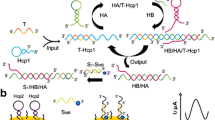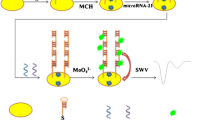Abstract
This paper describes an amperometric method for studying DNA-drug candidate interactions. It uses an automatted electrochemical biosensor (MiSens®) based on real-time electrochemical profiling and gold nanoparticles. A biochip was prepared from a 10 x 20 mm silicon dioxide wafer. The biochip surface is modified with a self-assembled monolayer and integrated into the microfluidic system. All the steps of the DNA-drug interaction assay have been performed during fluid flow. Biotinylated surface DNA has been captured on a NeutrAvidin -modified biochip surface. Hybridization of the complementary target sequence and biotinylated detection probe to the surface DNA strand was studied with and without the addition of newly synthesised drug candidates. NeutrAvidin and enzyme modified gold nanoparticles were then injected to bind to the biochip surface. The real-time reading of the amperometric response during the substrate injection results in the biosensor signal. The DNA interaction analysis was exemplarily applied to test the activity of paraben-substituted cyclotriphosphazenes as potential anticancer agents. Two of the synthesised compounds were identified that are capable of inducing DNA damage by 27 and 34%, respectively.

DNA-drug interactions can be investigated by an automated biosensor device that relies on Real-time Electrochemical Profiling (REP™).






Similar content being viewed by others
References
Erdem A, Ozsoz M (2002) Electrochemical DNA biosensors based on DNA-drug interactions. Electroanalysis 14:965–974
Kurbanoglu S, Dogan-Topal B, Rodriguez EP, Bozal-Palabiyik B et al (2016) Advances in electrochemical DNA biosensors and their interaction mechanism with pharmaceuticals. J Electroanal Chem 775:8–26
Zhou C, Dong Y, Li Z, Xu X, Liu Z (2010) Electrochemistry of magnolol and interaction with DNA. J Electroanal Chem 642:115–119
Bian C-L, Zeng Q-X, Yang L-J, Xiong H-Y et al (2011) Voltammetric studies of the interaction of rutin with DNA and its analytical applications on the MWNTs–COOH/Fe3O4 modified electrode. Sensors Actuators B Chem 156:615–620
Sönmez M, Çelebi M, Yardım Y, Şentürk Z (2010) Palladium(II) and platinum(II) complexes of a symmetric Schiff base derived from 2,6,diformyl-4-methylphenol with N-aminopyrimidine: Synthesis, characterization and detection of DNA interaction by voltammetry. Eur J Med Chem 45:4215–4220
Catalán M, Álvarez-Lueje A, Bollo S (2010) Electrochemistry of interaction of 2-(2-nitrophenyl)-benzimidazole derivatives with DNA. Bioelectrochemistry 79:162–167
Hlavata L, Striesova I, Ignat T, Blaskovisova J et al (2015) An electrochemical DNA-based biosensor to study the effects of CdTe quantum dots on UV-induced damage of DNA. Microchim Acta 182:1715–1722
Lu LP, Wu J, Li M, Kang TF, Cheng SY (2015) Detection of DNA damage by exploiting the distance dependence of the electrochemiluminescence energy transfer between quantum dots and gold nanoparticles. Microchim Acta 182:233–239
Chen F, Tu JJ, Liang CS, Yang B et al (2016) Fluorescent drug screening based on aggregation of DNA-templated silver nanoclusters, and its application to iridium (III) derived anticancer drugs. Microchim Acta 183:1571–1577
Fox JT, Sakamuru S, Huang RL, Teneva N et al (2012) High-throughput genotoxicity assay identifies antioxidants as inducers of DNA damage response and cell death. Proc Natl Acad Sci U S A 109:5423–5428
Yenilmez Çiftçi G, Tanrıverdi Eçik E, Yıldırım T, Bilgin K, Şenkuytu E, Yuksel F, Uludağ Y, Kılıç A (2013) Synthesis and characterization of new cyclotriphosphazene Compounds. Tetrahedron 69:1454–1461
Yıldırım T, Bilgin K, Yenilmez Çiftçi G, Tanrıverdi Eçik E, Şenkuytu E, Uludağ Y, Tomak L, Kılıç A (2012) Synthesis, cytotoxicity and apoptosis of cyclotriphosphazene compounds as anti-cancer agents. Eur J Med Chem 52:213–220
Gleria M, Jaeger RD, Applicative Aspects of Cyclophosphazenes (2004) NewYork
Bovin JO, Galy J, Labarre JF, Sournies F (1978) Cyclophosphazens as novel potential anti-tumor agents - X-ray crystal-structure of octapyrroliddinocyclotetraphosphazene. J Mol Struct 49:421–423
Asmafiliz N, Kılıç Z, Öztürk A, Hökelek T, Koç YL, Açık L, Kısa Ö, Albay A, Üstündağ Z, Solak AO (2009) Phosphorus nitrogen compounds 18. Syntheses, stereogenic properties, structure and electrochemical investigations, biological activities, and DNA interactions of new spirocyclic mono- and bisferrocenylphosphazene derivatives. Inorg Chem 48:10102–10116
Isıklan M, Asmafiliz N, Özlap E, Ilter EE, Kılıç Z, Çosut B, Yesilot S, Kılıç A, Öztürk A, Hökelek T, Koç YL, Açık L, Akyüz E (2010) Phosphorus nitrogen compound 21. Syntheses, structure investigations, biological activities, and DNA interactions of new N/O spirocyclic derivatives. The NMR behaviors of chiral phosphazenes with stereogenic centers upon the addition of chiral solvating agents. Inorg Chem 49:7057–7071
Huang WK, Yeh JT, Chen KJ (2001) Flame retardation improvement of aqueous based polyurethane with aziridinyl phosphazene curing system. J Appl Polym Sci 79:662–673
Allcock HR (2006) Recent developments in polyphosphazene materials science. Curr Opin Solid State Mater Sci 10:231–240
Barbera J, Bardaj M, Jimnez J, Laguna A, Martnez J, Serrano L, Zaragozano I (2005) Columnar mesomorphic organizations in cyclotriphosphazenes. J Am Chem Soc 127:8994–9002
Moriya K, Suzuki T, Yano S, Miyajima, (2001) 31P and 13C NMR studies of a liquide crystalline cyclotriphosphazene derivative: orientational characteristics and contrasting shielding anisotropies for inorganic and organic moieties. J Phys Chem B 105:7920–7927
Yenilmez Çiftçi G, Şenkuytu E, İncir S E, Yuksel F, Ölçer Z, Yıldırım T, Kılıç A, Uludağ Y (2016) First paraben substituted cyclotetraphosphazene compounds and DNA interaction analysis with a new automated biosensor. Biosens Bioelectron 80:331–338
Akbas H, Okumus A¸ Kılıç Z, Hökelek T, Süzen Y, Koç Y, Açık L, Çelik Z B (2013) Phosphorus nitrogen compounds part 27. Syntheses, structural characterizations, antimicrobial and cytotoxic activities, and DNA interactions of new phosphazenes bearing secondary amino and pendant (4-fluorobenzyl)spiro groups. Eur J Med Chem 70:294–307
Sournies F, Labarre JF (1986) Attempts at the production of more selective antitumourals: Part II. The antineoplastic activity of cyclophosphazenes linked to spermine. J Mol Struct 147:161–173
Dueymes M, Fournié G J. Conte-Mignon M, In S, Conte JJ (1986) Prevention of lupus diseases in MRLI, NZBxNZW, and BXSB mice treated with a cyclophosphazene derived drug. Clin Immun Immunopath 41:193–205
Görgülü A O, koran K, Özen F, Tekin S, Sandal S (2015) Synthesis, structural characterization and anti-carcinogenic activity of new cyclotriphosphazenes containing dioxybiphenyl and chalcone groups.J Mol Struct 1087:1-10
Amin A, Chauhan S, Dare M, Bansal AK (2010) Degradation of parabens by Pseudomonas beteli and Burkholderia latens. Eur J Pharm Biopharm 75:206–212
Valle P, Garcia Armesto MR, Arriaga D, Gonzalez Donquiles C, Rodriguez Fernandez P, Rua J (2016) Antimicrobial activity of kaempferol and resveratrol in binary combinations with parabens or propyl gallate against Enterococcus faecalis. Food Control 61:213–220
Taşkın GC, Durmuş M, Yüksel F, Mantareva V, Kussovski V, Angelov I, Atilla D (2015) Axially paraben substituted silicon(IV) phthalocyanines towards dental pathogen Streptococcus mutans: Synthesis, photophysical, photochemical and in vitro properties. J Photochem Photobiol A 306:31–40
Nes IF, Eklund T (1983) The effect of parabens on DNA, RNA and protein synthesis in Escherichia coli and Bacillus subtilis. J Appl Bacteriol 54:237–242
Uludag Y, Kokturk G (2015) Determination of prostate-specific antigen in serum samples using gold nanoparticle based amplification and lab-on-a-chip based amperometric detection. Microchim Acta 182:1685–1691
Uludag Y, Sagiroglu M, Ersoy A, Edis A, et al, (2015) An electrochemical sensor array and apparatus, PCT/IB2015/052479
Olcer Z, Esen E, Ersoy A, Budak S et al (2015) Microfluidics and nanoparticles based amperometric biosensor for the detection of cyanobacteria (Planktothrix agardhii NIVA-CYA 116) DNA. Biosens Bioelectron 70:426–432
Campuzano S, Pedrero M, Montemayor C, Fatas E, Pingarron JM (2006) Characterization of alkanethiol-self-assembled monolayers-modified gold electrodes by electrochemical impedance spectroscopy. J Electroanal Chem 586:112–121
Rusling JF, Hvastkovs EG, Schenkman JB (2007) Toxicity screening using biosensors that measure DNA damage. Curr Opi Drug Discovery Dev 10:67–73
Lu L-P, Wang S-Q, Lin X-Q (2004) Fabrication of layer-by-layer deposited multilayer films containing DNA and gold nanoparticle for norepinephrine biosensor. Anal Chim Acta 519:161–166
Altay C, Eksin E, Congur G, Erdem A (2015) Electrochemical monitoring of the interaction between Temozolamide and nucleic acids by using disposable pencil graphite electrodes. Talanta 144:809–815
Karadeniz H, Alparslan L, Erdem A, Karasulu E (2007) Electrochemical investigation of interaction between mitomycin C and DNA in a novel drug-delivery system. J Pharm Biomed Anal 45:322–326
Dogan-Topal B, Bozal-Palabiyik B, Ozkan SA, Uslu B (2014) Investigation of anticancer drug lapatinib and its interaction with dsDNA by electrochemical and spectroscopic techniques. Sensors Actuators B Chem 194:185–194
Temerk Y, Ibrahim H (2015) Electrochemical studies and spectroscopic investigations on the interaction of an anticancer drug flutamide with DNA and its analytical applications. J Electroanal Chem 736:1–7
Tajik S, Taher MA, Beitollahi H, Torkzadeh-Mahani M (2015) Electrochemical determination of the anticancer drug taxol at a ds-DNA modified pencil-graphite electrode and its application as a label-free electrochemical biosensor. Talanta 134:60–64
Kokturk G, Olcer Z, Narter F, Saglam E, Uludag Y (2014) Fast and sensitive detection of PSA in human serum with Real-time Electrochemical Profiling and nanoparticles amplification system. Journal of Biotechnology 185(Supplement):S20–S21
Acknowledgements
The authors thank to Gebze Technical University (GTU) for the provided financial support (Grant No: BAP-2013-A-013). The project is also supported by BILGEM-TUBITAK (The Scientific and Technological Research Council of Turkey; Grant no:100121). We gratefully acknowledge Bioelectronic Devices and Systems Group from BILGEM-TUBITAK for their contribution to the fabrication of the biochip and the sensing platform.
Author information
Authors and Affiliations
Corresponding authors
Ethics declarations
The author(s) declare that they have no competing interests.
Electronic supplementary material
CCDC 1054940–1054943 contain the supplementary crystallographic data for this paper. These data can be obtained free of charge at www.ccdc.cam.ac.uk/conts/retrieving.html, or from the Cambridge Crystallographic Data Centre (CCDC), 12 Union Road, Cambridge CB2 1EZ, UK; fax: +44(0)1223–336,033; email: deposit@ccdc.cam.ac.uk.
ESM 1
(DOC 2.49 mb)
Rights and permissions
About this article
Cite this article
Çiftçi, G.Y., Şenkuytu, E., İncir, S.E. et al. Characterization of paraben substituted cyclotriphosphazenes, and a DNA interaction study with a real-time electrochemical profiling based biosensor. Microchim Acta 184, 2307–2315 (2017). https://doi.org/10.1007/s00604-017-2162-y
Received:
Accepted:
Published:
Issue Date:
DOI: https://doi.org/10.1007/s00604-017-2162-y




